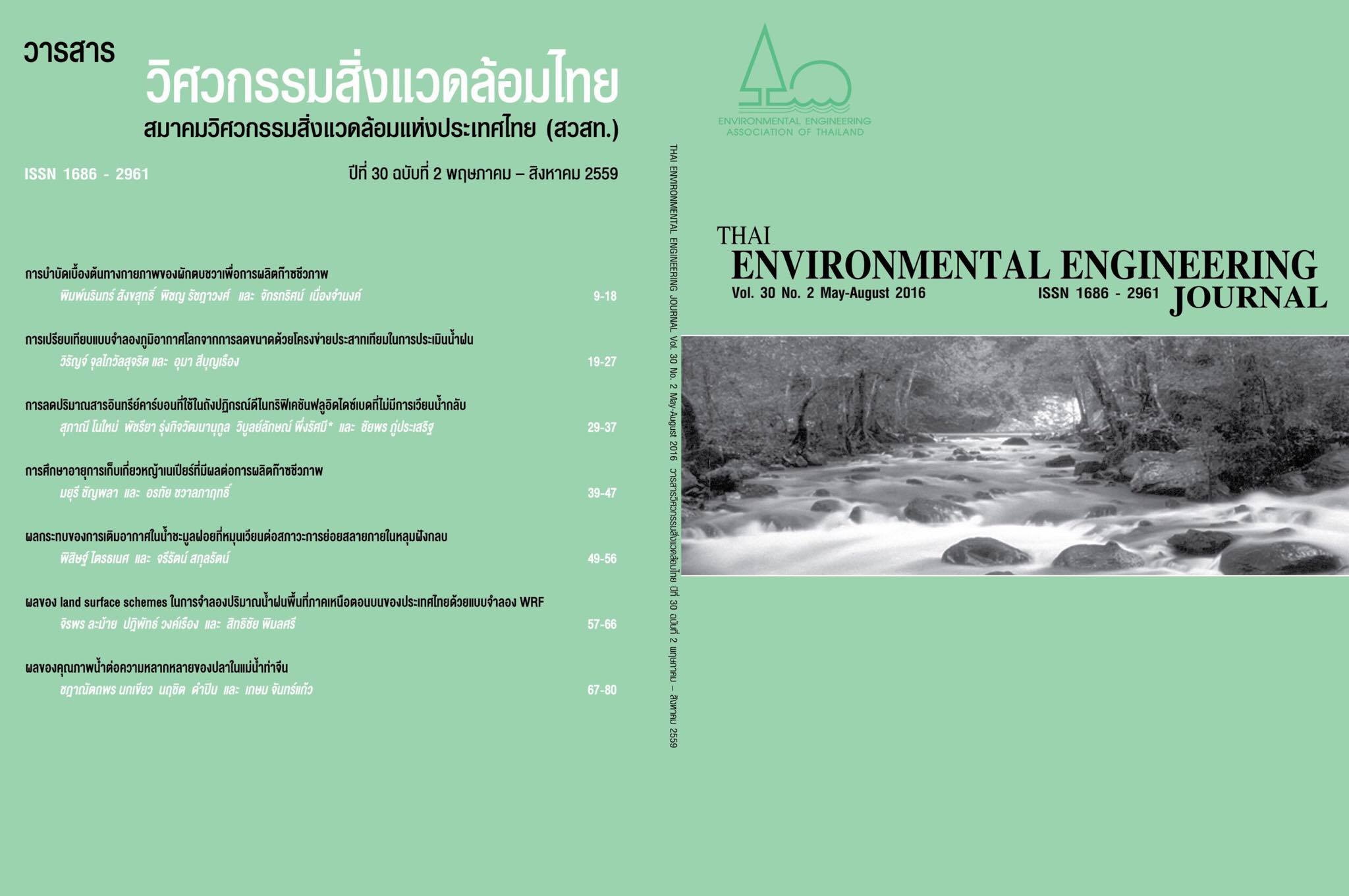Comparison of Global Climate Models Downscaled by Artificial Neural Network to Estimate Rainfall
Main Article Content
Abstract
Recently, a disaster as Flooding and drought has damaged lives and assets. The Global Climate Models has been tool for predicting Climate Change including a future-rainfall. Because it had coarse resolution and many models and made from many countries, needed a downscaling process to be increasing accuracy and selecting suitable models to use in an area. This research used 4 models of the Fourth Assessment Report of the Intergovernmental Panel on Climate Change (AR4) consisting of HADcm3 model, ECHAM5 model, BCCR-BCM2.0 model and CGCM3.1 (T47) model from England, Germany, Norway and Canada, respectively. Moreover, an observed rainfall-data (A.D.1965-2014) of 5 Province from Thai Meteorological Department, consisting of Chaingmai, Nongkai, Sukhothai, Ubonratchathani and Phuket provinces, and an Artificial Neural Networks were used to downscaling, statistic variable was also used to appropriate models. Base on annual units, the resultant selection shown the best suitability for HADcm3 was 3 provinces composed of Chaingmai, Nongkai and Phuket whereas BCCR-BCM and ECHAM5 were with Sukhothai and Ubonratchathani, respectively. CGCM was not suitability for any province base on annual units. The 5-years future rainfall (A.D.2014-2018) from selectively downscaled models compared with historic rainfall data presented a decreasing rainfall 5.22% in Chaingmai, 16.37% in Nongkai, 10.71% in Ubonratchathani and 24.17% in Phuket while it increased 13.98% in Sukothai. The 10-years future rainfall (A.D.2014-2023) from selectively downscaled models compared with historic rainfall data presented a decreasing rainfall 10.79% in Chaingmai, 9.4% in Nongkai, 2.44% in Ubonratchathani and 14.68% in Phuket whilst it increased 49.68% in Sukothai. The 25-years future rainfall (A.D.2014-2038) from selectively downscaled models compared with historic rainfall data presented a decreasing rainfall 6.95% in Chaingmai and 1.09% in Ubonratchathani while it increased 13.98 in Sukothai, 0.68% in Nongkai and 12.20% in Phuket.
Article Details
Section
Research Articles
References
[1] Intergovernmental Panel on Climate Change, What is GCM?, Emission scenario. Cambridge University, 2000.
[2] Colin Fyfe, Department of Computing and Information System, Learning in artificial neural network, Artificial Neural Network and Information Theory. The University of Paisley, 2000.
[3] Daniel Graupe, Introduction, Learning Performance Enhancement, Back Propagation, Principle of Artificial Neural Network. World Scientific Publishing Co., 2007.
[4] Siddi Tengeleng., Nzeukou Armand, Performance of Using Cascade Forward Back Propagation Neural Networks for Estimating Rain Parameters with Rain Drop Size
Distribution. ATMOS OCEAN 2014, 5:454-472.
[5] Francois Rivest, Knowledge Transfer in Neural Network: Knowledge-Base Cascade Correlation. Thesis, Faculty of Graduate Studues and Research,
School of computer Science, McGill University. 2002.
[6] Khaled Shaban, Ayman EI-Hag, Andrei Matveev, A cascade of artificial Neural Network, IEEE T DIELECT EL IN (Impact Factor:1.28). 05/2009; 16(2): 516-523.
[7] Dheeraj S. Badde, Anil k. Gupta, Vinayak K. Patki, Cascade and Feed Forward Back propagation Artificial Neural Network Model for Precipitation of Compressive Strength of Ready Mix Concrete, J MATH ENG SCI: ISSN 2278-1684; 1-6.
[8] Piyatida Ruangrassamee., Arkom Khamkong., Pavisorn Chuenchum, Assessment of Precipitation simulations from CMIP5 climate Models in Thailand. The 3rd EIT International Conference on water Resource Engineering, 2015: 591-599.
[9] Steel, R. G. D., J. H. Torrie. Principles and Procedures of Statistics, Biometrische Zeitschrift, 2007; vol4: 207-208.
[2] Colin Fyfe, Department of Computing and Information System, Learning in artificial neural network, Artificial Neural Network and Information Theory. The University of Paisley, 2000.
[3] Daniel Graupe, Introduction, Learning Performance Enhancement, Back Propagation, Principle of Artificial Neural Network. World Scientific Publishing Co., 2007.
[4] Siddi Tengeleng., Nzeukou Armand, Performance of Using Cascade Forward Back Propagation Neural Networks for Estimating Rain Parameters with Rain Drop Size
Distribution. ATMOS OCEAN 2014, 5:454-472.
[5] Francois Rivest, Knowledge Transfer in Neural Network: Knowledge-Base Cascade Correlation. Thesis, Faculty of Graduate Studues and Research,
School of computer Science, McGill University. 2002.
[6] Khaled Shaban, Ayman EI-Hag, Andrei Matveev, A cascade of artificial Neural Network, IEEE T DIELECT EL IN (Impact Factor:1.28). 05/2009; 16(2): 516-523.
[7] Dheeraj S. Badde, Anil k. Gupta, Vinayak K. Patki, Cascade and Feed Forward Back propagation Artificial Neural Network Model for Precipitation of Compressive Strength of Ready Mix Concrete, J MATH ENG SCI: ISSN 2278-1684; 1-6.
[8] Piyatida Ruangrassamee., Arkom Khamkong., Pavisorn Chuenchum, Assessment of Precipitation simulations from CMIP5 climate Models in Thailand. The 3rd EIT International Conference on water Resource Engineering, 2015: 591-599.
[9] Steel, R. G. D., J. H. Torrie. Principles and Procedures of Statistics, Biometrische Zeitschrift, 2007; vol4: 207-208.


